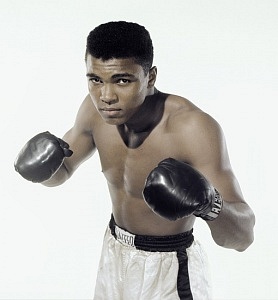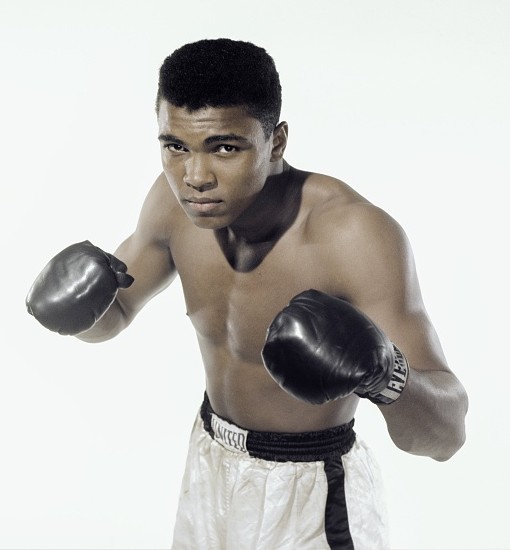Muhammad Ali the Fighter: Speed, Stamina and Psychological Warfare
The champ was despised and beloved but was a warrior for racial justice and peace
By GORDON MARINO, Wall Street Journal, June 4, 2016
 Asked to describe the man he trained for over 20 years, Angelo Dundee shook his head in wonder and replied, “Being with Muhammad was like riding a comet,” and a comet he was. First despised then beloved, Ali was a warrior for racial justice and peace. He was the first athlete to transcend sports. But for all his transcendence outside of the ring, we should never forget what a transcendent performer he was in the ring.
Asked to describe the man he trained for over 20 years, Angelo Dundee shook his head in wonder and replied, “Being with Muhammad was like riding a comet,” and a comet he was. First despised then beloved, Ali was a warrior for racial justice and peace. He was the first athlete to transcend sports. But for all his transcendence outside of the ring, we should never forget what a transcendent performer he was in the ring.
Then Cassius Clay, Ali won the Olympic Gold medal in Rome in 1960. As he moved up the heavyweight ranks toward a title shot, the fighter known as the “Louisville Lip” used to boast, “I’m so fast that last night I turned off the light switch in my hotel room and was in bed before the room was dark.” Some fighters have quicksilver hands, others flash dance foot-speed, but Ali was lightning from top to bottom.
In the 20s, Gene Tunney proved that speed and lateral movement could defang a mauler like Jack Dempsey, but no heavyweight before or after the Great One could dance like the balletic Ali.
Boxing wise, he was a one-two combination of grace and violence. A smidgen over 6’3”, Ali fought tall and on his toes, with loose shoulders and torso, and always with a slight bend in his knees. In his prime, and with his hands below his waist, Ali would dance side to side and force his flummoxed foes to keep turning and firing punches that missed their mark by a foot. Most boxers can only punch coming forward but with his impeccable balance, Ali could bang in retreat. And when the matador decided the time was ripe, he would overwhelm his opponents with long, sizzling combinations.
World championship boxing requires untold mental muscle. Fighters have to negotiate powerful increments of fear while mobilizing the aggression to step into the danger zone and deliver their own packages of destruction. Though a naturally pacific person, Ali was as comfortable in the frothing violence of the ring as someone in a casual game of beach volleyball.
A magician and a trickster, the Great One was able to inspire strangers with newfound confidence; however, he was also a master of psychological warfare who could pick the pockets of his opponent’s belief in themselves.
The blows to the psyche didn’t end when the battle began. In his epic 1974 victory over George Foreman in Zaire, he was whispering in Foreman’s ear the whole time, “Is that all you got, George?” The preternaturally powerful Foreman believed that Ali would be the easiest fight of his career but Foreman once told me, “By round 6, I was thinking, ‘Yeah that’s about all I got.’” In his third fight with the immortal Joe Frazier, Ali was singing nursery rhymes to Smokin’ Joe when they were in the clinches.
In the beginning of his career, most boxing experts believed that speedster with the movie star good looks wouldn’t be able to take a punch. Nothing could have been further from the truth.
Though he was always somewhat vulnerable to left hooks, Ali’s capacity to absorb punishment had much to do with his ability to detect a punch even as his opponent was just thinking about the blow. This radar sense of anticipation enabled him to turn with shots and so drain force from the bear-like swipes of a Sonny Liston or George Foreman.
However, after his three plus year hiatus from the ring following his refusal to be drafted, Ali was no longer the whirling dervish that he had once been. He was easier to hit. But even when he took his drubbings, there was no beating down his will to win. His jaw was broken in the first stanza of his 1973 brawl with Ken Norton and yet despite the protestations of his trainer, Ali fought the remaining 11 rounds in agony. After the war of their 1975 third matchup, “The Thrilla’ in Manila,” Joe Frazier acknowledged Ali’s superhuman grit saying, “I hit him with punches that’d bring down the walls of a city.”
As for punching prowess, Ali didn’t pack the dynamite of a George Foreman. He had respectable power with 37 of his victories coming by way of knockouts. But more than sheer concussive force, he possessed pinpoint accuracy and was able to time his shots when his opponents were leaning in and place them at junctures on the chin that short circuit the brain—just consider his 15th round TKO of the bull, Oscar Bonavena in 1970.
Boxing was in a moribund state in the early 60s, but with his showmanship and sublime skills, Ali single-handedly lifted the bruising game off the canvas by compelling the attention of millions of people with only a casual interest in the sport.
A three-time world champion, Ali’s final ledger reads 56-5-0 (37 KOs). Over his 21-year career, he faced and defeated a murderer’s row of heavyweights, including Sonny Liston, Floyd Patterson, Oscar Bonavena, Ernie Terrell, George Chuvalo, Joe Frazier, Ken Norton, Jerry Quarry, Ron Lyle, and George Foreman. He fought frequently and ducked no one.
Philosopher Blaise Pascal wrote, “the fifth act is always bloody.” It is true in life and in boxing. Like Joe Louis, the other heavyweight king of kings with whom he is so often compared, Ali came back for one too many encores and was brutally dissected by a tearful Larry Holmes in 1980 and then dismantled again by Trevor Berbick in 1981.
And yet if there was one, only one shining moment in his career that could be fixed in our collective memory, it might be the instant in Zaire when Ali once again shook the world. It is the eighth round and George Foreman is pirouetting toward the canvas on the end of an Ali right hand. Ali is following him and had his fist cocked to level a finishing touch, but he doesn’t deliver the blow. Years later, Angelo Dundee would explain, “Muhammad held back because he knew George was finished and he never wanted to hurt anyone. That’s just the way he was.”
